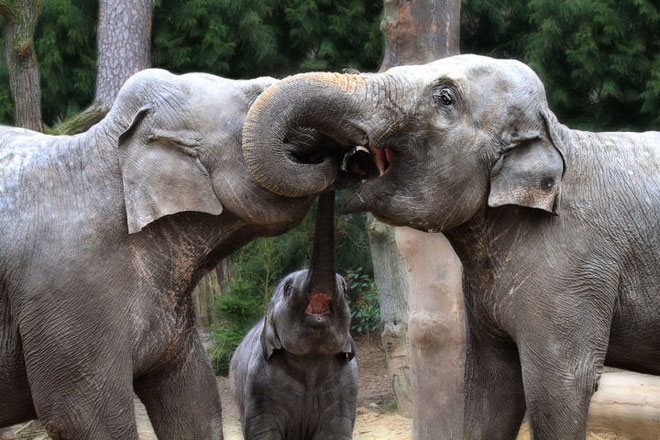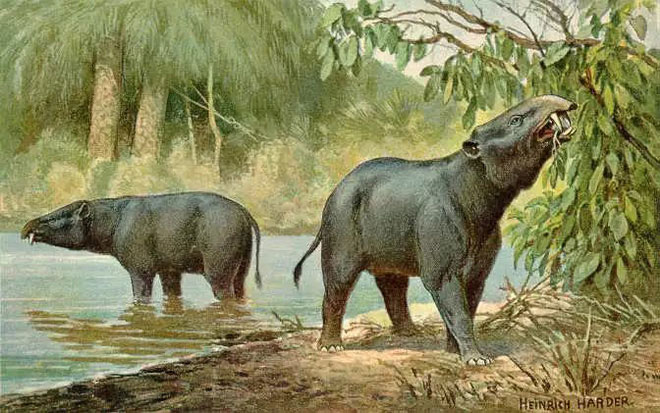Why did the elephant's nose evolve so long?
We all know that elephants use their noses to mess up almost everything, not just to breathe, this sedge is also flexible that can act as an arm and a device. receive signals, water pumps, hoses . Specifically, elephants will use them to get food, water, bath or as a weapon to defeat enemies. Or they can be used to express affection, express love, greetings, etc. And all of this began with the prehistoric ancestors of elephants.

Elephants use their noses (proboscis) to mistake nearly everything.
Currently there are only three species of elephants in the world: Asian elephants, African prairie elephants and African forest elephants . In addition, the other elephants mentioned in this article are all extinct.
When it comes to elephant ancestors, many people may think of their ancestors that appeared 47 million years ago. From the outside, it looks like a combination of a tapir and a hippopotamus, but only the size of a pig.
It does not have a long nose like modern elephants, but their noses and lips are interconnected, making this nose extremely flexible. In addition, their teeth are almost similar to those of modern elephants. Therefore, at first people thought that it was the most primitive ancestor of modern elephants. In fact, after much research, scientists have identified it as just a branch of an ancient elephant that became extinct.

Moeritherium, meaning beast from Lake Morris.
12 million years later another mammal began to appear and had teeth protruding like tusks, they were called Palaeomastodon . And scientists now believe that this species is really the ancestor of modern elephants.
They lived about 36 - 35 million years ago, the Palaeomastodon living near the Sahara desert in North Africa today. However, at that time, this desert area was completely tropical swamps.
This means that most of the earliest ancestors of elephants lived in areas with lots of water . Based on this, there is some speculation that the nose has evolved to support breathing, diving, and swamping.
However, with climate change such as forests disappearing, oceans and rivers running out along with other geographic factors, these ancient elephants were forced to move up to the surface. Hard to live on.

Most of the earliest ancestors of elephants lived in areas with lots of water.
The above hypothesis is currently considered to be the most plausible explanation, but it still does not solve the problem. That's why the elephant's nose gets longer?
From the ancestral fossil restoration map of the elephant, the ancient mastodon has a relatively short nose. Instead, they have flat lower teeth that look like a giant shovel. Scientists speculate that their lower teeth structure is convenient for picking plants in the water when searching for food in the swamp .
In fact, things changed when ancient elephants moved to live on land . In general, terrestrial herbivores need to be much higher than carnivores. Because good height will help them not to compete for food with ground herbivores, in addition to being taller will have a greater view to avoid predators. To survive, ancient elephants also need to evolve, resize to adapt to new habitats. As a result, the elephant's body gets bigger, longer and taller, its head farther and farther away from the ground.

To survive, ancient elephants also need to evolve, resize to adapt to new habitats.
But this means that it will be more difficult to be able to eat young grass on the ground, many other animals such as cows, horses, camels choose to evolve their necks to be able to bend down to eat the grass below the ground, and you can also rise to enjoy the plants above.
Compared to other animals, an elephant's head is relatively heavy. If their necks are longer, they will need strong neck muscles to support the head. But when combined with oversized tusks, the weight of an elephant's head would be hundreds of kilograms, so if such a currency they would need a huge long neck as well as a bigger body, and that This seems like an easy challenge, so elephants have chosen another evolutionary path.

Platybelodon lived in the Miocene, about 15-4 million years ago, and distributed in Africa, Europe, Asia and North America.Although once thriving, it did not exist through the Miocene.
In some ancient elephants, when they could not evolve to extend their necks, they evolved in a way that gradually extended their jawbone to gain access to ground food, such as Platybelodon. They are very strange elephants that appeared in the Miocene era. Their jaws are extremely long and its front has a pair of flat incisors in the lower jaw.

This species also has another name is elephant tooth shovel.
With such a bizarre appearance, this species also has another name: elephant tooth shovel , their strange mouth resembles the combination of a duck and a muzzle of wild boars. Initially, people thought that this species forage in the mud and swamps. However, research has found that shovel toothed elephants have the same behavior as modern elephants, often foraging for food from trees.
Looking through a microscope, scientists discovered that their teeth had a lot of traces of rubbing against tree branches. Although once thriving, it did not exist through the Miocene.
Next is the Deinotherium species living in Eurasia from Africa from Miocene to Pleistocene, with the largest individual up to 12 tons and body length of nearly 8 meters.

Deinotherium is a prehistoric relative of modern elephants today.
Unlike modern elephants, Deinotherium is a prehistoric relative of modern elephants today, they appeared in Central Miocene and survived until the Pleistocene period. From the fossils discovered, paleontologists believe that they have a behavior similar to that of modern elephants and have fangs bent down to attach to the lower jaw.
Scientists speculate that their peculiar tusks are used to rip open bark. And this also makes the ancestors of the elephant skull thicker heavier and stronger, followed by a "lumpy" neck full of strong muscle.

These peculiar tusks are used to rip open bark.
Because of the thick and heavy skull and the large pair of tusks, it makes it very difficult for them to graze on the ground, so they evolved to change the weight of the head and muscle. can step backwards. Through generations of evolution, the head and chin of elephants have become shorter, while the nose continues to grow and change more flexibly.
And elephants that don't continue to evolve to own a long nose will lose their competitive advantage and climate change will make their living environment worse, which will lead to the evolution of non-evolutionary species. extinction.
In fact, the elephant's nose is very soft and flexible, it can hold 40,000 muscles. And they have become the most important authorities in elephants. With precise muscle contraction, an elephant's nose can do many things. It can lift several hundred kilograms in weight or wipe the eyes very gently.
- The truth is that the ancestors of elephants and ancient rhinos had a much more "bizarre" appearance today!
- Name the "weird" animals that once dominated the Earth
- Ancient long-haired mammoths
- Catching the long nose, strange poisonous thorns
- Why is it difficult to see elephants confirm?
- Detection of hairy pig nose mice in the longest
- The science explains why our nose is flat, the western tip is high
- Why is the Vietnamese nose low but the Westerners are high?
- Rare dwarf elephants die in mass
- Strange noses in the animal world
- Why is the 'giant' elephant afraid of 'tiny' ants?
- Bloody nose, cause?
- Revealing the 'gold' indicator of the perfect nose
- Giant elephants release technology like smoke ... smoking in the forest in India
 'Fine laughs' - Scary and painful torture in ancient times
'Fine laughs' - Scary and painful torture in ancient times The sequence of numbers 142857 of the Egyptian pyramids is known as the strangest number in the world - Why?
The sequence of numbers 142857 of the Egyptian pyramids is known as the strangest number in the world - Why? History of the iron
History of the iron What is alum?
What is alum?